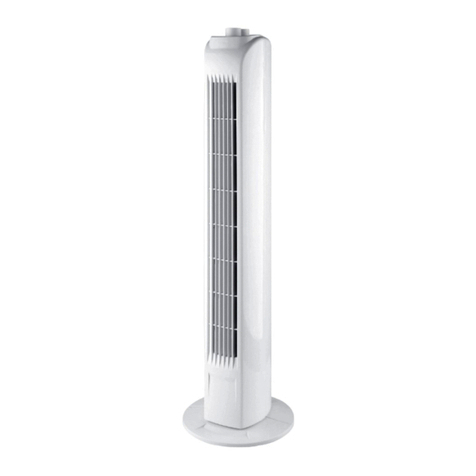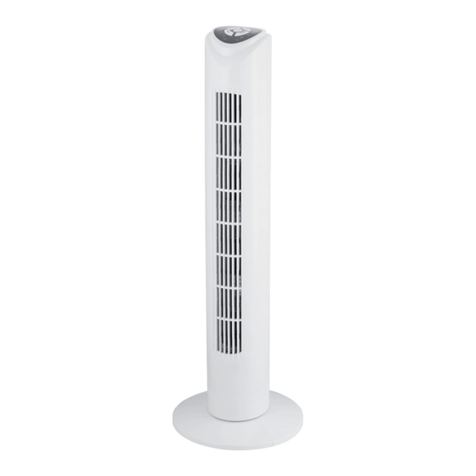
3
Standventilator
Inhaltsverzeichnis
Bevor Sie beginnen… . . . . . . . . . . . . . . . . . . . . . 3
Zu Ihrer Sicherheit . . . . . . . . . . . . . . . . . . . . . . . 3
Ihr Gerät im Überblick . . . . . . . . . . . . . . . . . . . . 4
Montage . . . . . . . . . . . . . . . . . . . . . . . . . . . . . . . . 4
Vorgang . . . . . . . . . . . . . . . . . . . . . . . . . . . . . . . . 5
Reinigung. . . . . . . . . . . . . . . . . . . . . . . . . . . . . . . 5
Störungen und Hilfe . . . . . . . . . . . . . . . . . . . . . . 5
Entsorgung . . . . . . . . . . . . . . . . . . . . . . . . . . . . . 5
Technische Daten . . . . . . . . . . . . . . . . . . . . . . . . 5
Mängelansprüche . . . . . . . . . . . . . . . . . . . . . . . 49
Bevor Sie beginnen…
Bestimmungsgemäßer Gebrauch
Das Gerät ist ausschließlich zum nichtgewerblichen
Betrieb als mobiler Ventilator bestimmt.
Das Gerät ist nicht für den gewerblichen Gebrauch
konzipiert. Allgemein anerkannte Unfallverhütungs-
vorschriften und beigelegte Sicherheitshinweise
müssen beachtet werden.
Führen Sie nur Tätigkeiten durch, die in dieser
Gebrauchsanweisung beschrieben sind. Jede
andere Verwendung ist unerlaubter Fehlgebrauch.
Der Hersteller haftet nicht für Schäden die hieraus
entstehen.
Was bedeuten die verwendeten Symbole?
Gefahrenhinweise und Hinweise sind in der
Gebrauchsanweisung deutlich gekennzeichnet. Es
werden folgende Symbole verwendet:
Zu Ihrer Sicherheit
Allgemeine Sicherheitshinweise
• Für einen sicheren Umgang mit diesem Gerät
muss der Benutzer des Gerätes diese
Gebrauchsanweisung vor der ersten Benutzung
gelesen und verstanden haben.
• Beachten Sie alle Sicherheitshinweise! Wenn Sie
die Sicherheitshinweise missachten, gefährden
Sie sich und andere.
• Bewahren Sie alle Gebrauchsanweisungen und
Sicherheitshinweise für die Zukunft auf.
• Wenn Sie das Gerät verkaufen oder weiterge-
ben, händigen Sie unbedingt auch diese
Gebrauchsanweisung aus.
• Das Gerät darf nur benutzt werden, wenn es ein-
wandfrei in Ordnung ist. Ist das Gerät oder ein
Teil davon defekt, muss es außer Betrieb
genommen und fachgerecht entsorgt werden.
• Verwenden Sie das Gerät nicht in explosionsge-
fährdeten Räumen oder in der Nähe von brenn-
baren Flüssigkeiten oder Gasen!
• Ausgeschaltetes Gerät immer gegen unbeab-
sichtigtes Einschalten sichern.
• Benutzen Sie keine Geräte, bei denen der Ein-
Aus-Schalter nicht ordnungsgemäß funktioniert.
• Halten Sie Kinder vom Gerät fern! Bewahren Sie
das Gerät sicher vor Kindern und unbefugten
Personen auf.
• Überlasten Sie das Gerät nicht. Benutzen Sie
das Gerät nur für Zwecke, für die es vorgesehen
ist.
• Immer mit Umsicht und nur in guter Verfassung
arbeiten: Müdigkeit, Krankheit, Alkoholgenuss,
Medikamenten- und Drogeneinfluss sind unver-
antwortlich, da Sie das Gerät nicht mehr sicher
benutzen können.
• Dieses Gerät ist nicht dafür bestimmt, durch
Personen (einschließlich Kinder) mit einge-
schränkten physischen, sensorischen oder geis-
tigen Fähigkeiten oder Mangel an Erfahrung
und/oder Wissen benutzt zu werden, es sei
denn, sie werden durch eine für ihre Sicherheit
zuständige Person beaufsichtigt oder erhielten
von dieser Anweisungen, wie das Gerät zu
benutzen ist.
• Stellen Sie sicher, dass Kinder nicht mit dem
Gerät spielen.
• Immer die gültigen nationalen und internationa-
len Sicherheits-, Gesundheits- und Arbeitsvor-
schriften beachten.
Elektrische Sicherheit
• Das Gerät darf nur an eine Steckdose mit ord-
nungsgemäß installiertem Schutzkontakt ange-
schlossen werden.
• Die Absicherung muss mit einem Fehlerstrom-
Schutzschalter (FI-Schalter) mit einem Bemes-
sungsfehlerstrom von nicht mehr als 30mA
erfolgen.
• Vor Anschließen des Gerätes muss sicherge-
stellt sein, dass der Netzanschluss den
Anschlussdaten des Gerätes entspricht.
• Das Gerät darf nur innerhalb der angegebenen
Grenzen für Spannung und Leistung verwendet
werden (siehe Typenschild).
• Netzstecker nicht mit nassen Händen anfassen!
Netzstecker immer am Stecker, nicht am Kabel
herausziehen.
• Netzkabel nicht knicken, quetschen, zerren oder
überfahren; vor scharfen Kanten, Öl und Hitze
schützen.
• Gerät nicht am Kabel anheben oder Kabel
anderweitig zweckentfremden.
• Kontrollieren Sie vor jeder Benutzung Stecker
und Kabel.
GEFAHR! Unmittelbare Lebens- oder
Verletzungsgefahr! Unmittelbar gefährli-
che Situation, die Tod oder schwere Verlet-
zungen zur Folge haben wird.
WARNUNG! Wahrscheinliche Lebens-
oder Verletzungsgefahr! Allgemein
gefährliche Situation, die Tod oder schwere
Verletzungen zur Folge haben kann
VORSICHT! Eventuelle Verletzungsge-
fahr! Gefährliche Situation, die Verletzun-
gen zur Folge haben kann.
ACHTUNG! Gefahr von Geräteschäden!
Situation, die Sachschäden zur Folge
haben kann.
Hinweis: Informationen, die zum besseren
Verständnis der Abläufe gegeben werden.
DE
Standventilator_477573.book Seite 3 Dienstag, 15. November 2016 3:33 15





























